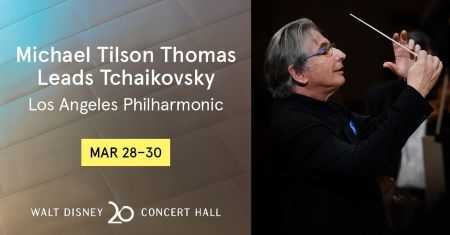The third and final performance of this program by the LA Phil with guest conductor Michael Tilson Thomas took place March 30 at Disney Hall. The orchestra was in standard setup as MTT entered the stage to very warm applause. He cheerily addressed his audience and his musicians as he set to work.
First on the program was Petrushka, Igor Stravinsky’s concert version of his folktale-based ballet about enchanted puppets and their love troubles. The piece is a wildly dramatic ride, sprinkled with tranquil lullaby-like moments and Russian folk tunes. The brass section is featured at the start with excited and anticipatory music with hints of a more lyrical folk melody furthered by the reed section. The strings and timpani abruptly interrupt the mood only to restore the nationalistic march-like folk song. Musical mood swings such as this are intrinsic to the piece. Another swing was particularly humorous when the contra-bassoon emitted a sound like a bodily function, which brought chuckles from the audience, and gave way to a romantically legato flute solo by Denis Bouriakov. Other musical qualities which resonated were the crisp sharpness of the xylophone, the soothing and curious dreaminess of the piano soloist’s interchanges with the flute, and the gentleness of the kettle drums as if sounding from a distance. With the basses and cellos leading a reprise of the nationalistic march, the concluding music was bright and confidently uplifting.
After MTT gestured to various soloists and sections to stand, there was a hurried exchange and a shuffling of scores on music stands as the Maestro led the players in a surprise reprise of the concluding section of the piece.
Tchaikovsky’s Symphony No. 4 in F minor. Op.36 was the second half of the evening. Composed in 1877, the piece is a dedication to his patroness of thirteen years, referring to it as their shared symphony. In four movements, it is a musical exploration of life, its journey of emotions, and the pursuit of happiness.
The symphony explodes with a bold annunciatory fanfare by the horns introducing the “Fate” theme. A regal Russian sounding theme is picked up by the strings and the reeds follow suit. The music swells like a raging sea, leading into a playful prancing dance-like motif. Full of dramatic longing, we hear the French horn, flutes, clarinets, and bassoons in a cascading interplay which is intriguingly interesting. The second movement features a lilting oboe solo, expressive in its mournful sadness while still evoking a lullaby-like air. The third is all about the string section and their pizzicato plucking, very reminiscent of Nutcracker. The oboes have their turn next with a medieval-hinted motif played astoundingly well by piccolo soloist Sarah Jackson, who had been waiting patiently throughout the previous movements. The movement finished with the pizzicato theme in a state of serenity.
Cymbals crashing and high strings in a dramatic tempo return us to the state of frenzied emotion that is the fourth movement. After a bird-sounding flute solo, the brass brings back the dramatic “Fate” theme. The composer reintroduces a bolstering folk melody, navigating our return to the Russian homeland.
MTT, lifting and rubbing his burgundy bound score, smiled with pleased satisfaction as well he should have. After some soloist and section acknowledgements, he left the stage, only to beamingly return with his grey poodle who accompanied him back out to his podium and laid down.
A side note: My seat was in Terrace East. I had never sat there before and found it to be a distinctly unique experience from the Orchestra or Balcony seating where you face the stage straight on. This Terrace offers a bird’s-eye view, more inclusive of musician sections like percussionists and horns which can be difficult or impossible to see behind the conductor podium and the strings from an Orchestra seat. Also, you can see the conductor and his communications with his orchestra, thus adding further insight to the experience.

